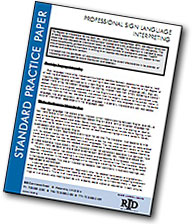

Interpreting Overview...

The Key to Our Success is in our Hands...
At CODA Link, Inc., our interpreters are multicultural and multi-lingual and have extensive background knowledge and expertise in a variety of settings and possess the vernacular necessary to facilitate effective communication in all arenas. Interpreters hold a position of trust in their role as linguistic and cultural mediators. Integrity, professionalism, attitude and image are important core values to CODA Link, Inc. Interpreters not only need to possess the skills required to perform the job, but they must have the right attitude and demeanor — something we refer to as the "likeability factor." You can be assured that our interpreters are respectful, professional, knowledgeable of their role, and dignified.
Art of Interpreting
The interpreting process requires a high level of cognitive, linguistic and technical skill. Interpreters are highly skilled and have the ability to receive the message in one language and deliver it in to another language. Interpreters are trained to achieve the equivalence by conveying the spirit and intent of the message.
|
Simultaneous Interpreting
Simultaneous interpretation requires the interpreter to listen (either visually or audio logically), sign/speak and process the message at the same time. This means that the interpreter begins to interpret in the target language while listening or watching the message being rendered in the source language.
With this model, the speaker will begin with several thoughts and one or more sentences. The interpreter takes this information “in chunks” and reproduces in a conceptually accurate message. This style takes a little longer but has the advantage of being more accurate, allowing more time to process. It works ideally in a one-on-one setting.
Team Interpreting
Team interpreting is two interpreters sharing an assignment. Interpreters are working in conjunction with one another as support or back up when providing services to a consumer. Team interpreters rely on each to provide missed information, technical vocabulary and assistance in voice interpretation as well as physical relief. In team situations, both interpreters are "on" at all times, not just the interpreter who is moving his/her hands.1
It is recommended that a team of at least two interpreters be assigned to any assignment that is two hours or more in length.
There are several reasons to support team interpreting. Interpreting for extensive hours is quite taxing; teaming reduces interpreter fatigue and reduces the risk of Repetitive Motion Injury (RMI).
Please refer to www.rid.org for more information.
by Tammera J. Fisher, CI, NAD Level IV: Advanced, Butte Publications, Inc., ISBN 1-884362-03-6.

